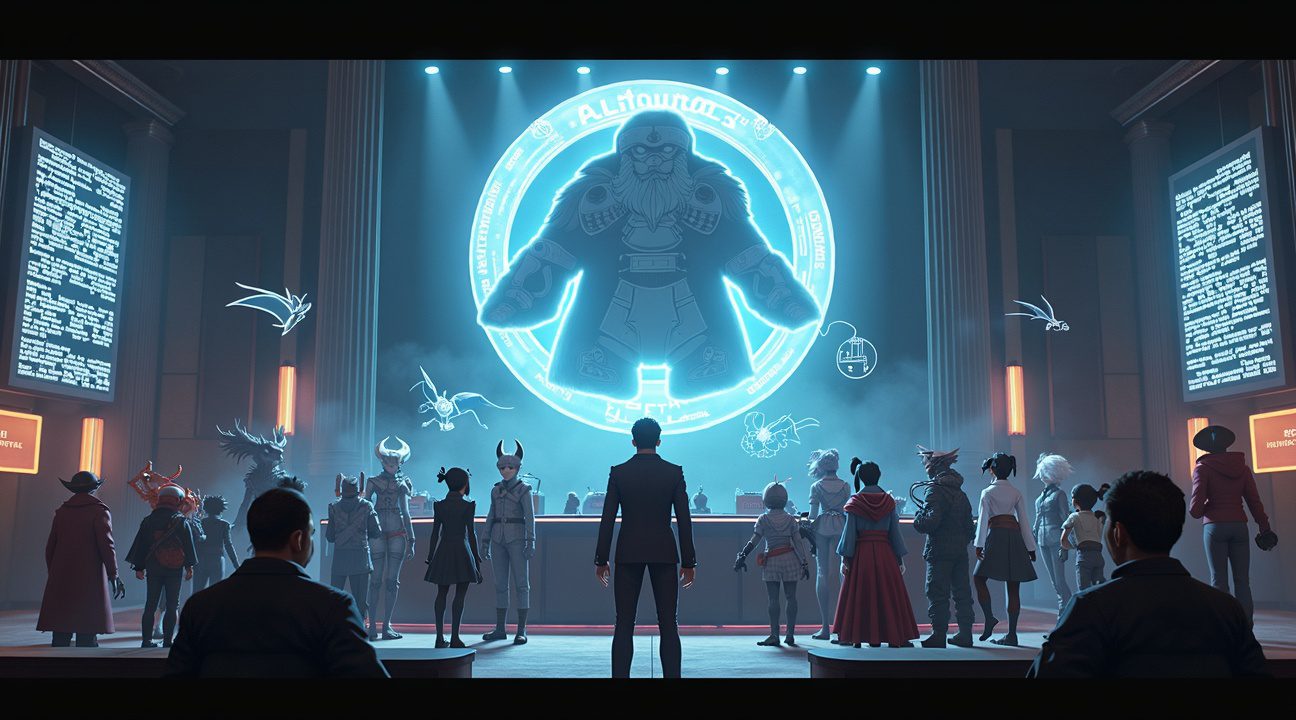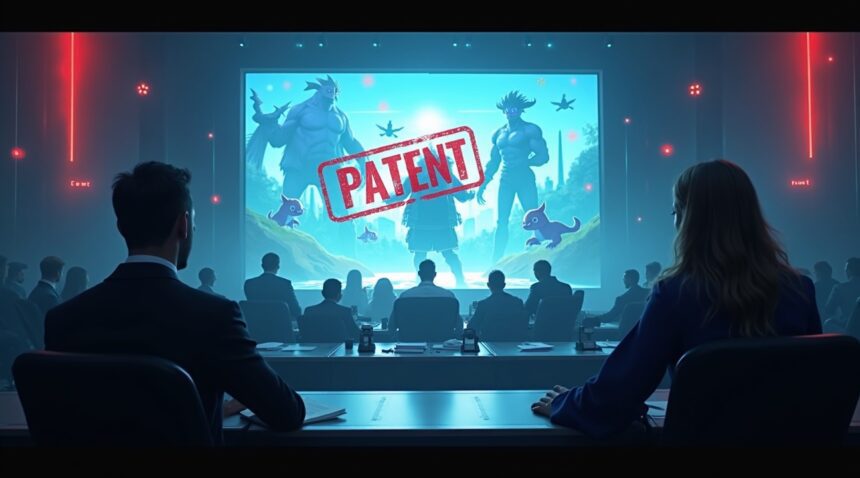Nintendo’s recent patent approval for gameplay mechanics involving creature summoning has sparked widespread concern throughout the gaming industry, as experts warn it may hinder creative freedom and development in the genre.
Overview of U.S. Patent No. 12,403,397
The U.S. Patent and Trademark Office granted U.S. Patent No. 12,403,397 to Nintendo, which covers mechanics related to summoning sub-characters in games. These mechanics allow players to direct summoned creatures to engage in real-time or delayed battles based on their placement during gameplay. Although Nintendo claims the innovation is unique, many industry experts argue the concepts have long existed in gaming titles.
Mechanics Covered in the Patent
- Summoning sub-characters into a battle environment
- Strategic placement of summoned creatures determines when and how they engage in combat
- Battles can initiate immediately if the space is occupied by an enemy or be delayed if positioned in vacant spaces
Industry Reaction and Legal Concerns
Multiple IP lawyers and game developers have labeled the patent’s approval as extremely controversial. Many believe it overreaches into gameplay mechanics that have long been foundational across a variety of games.
Potentially Affected Games
- Palworld – an indie game where players collect and command creatures in combat settings
- Monster Hunter Stories – utilizes creature engagement similar to Nintendo’s patented methods
- Persona series – well-known for strategic creature summoning during battles
- Independent games with creature-collecting mechanics may now face legal scrutiny or licensing pressures
Expert Criticism and Broader Implications
- IP professionals describe the patent as “outrageous” and believe it should have been declined due to lack of novelty
- Innovation risks arise as smaller studios may not afford legal battles or licensing costs
- Encouraging precedent could lead other major companies to patent basic gameplay ideas
Conclusion
The approval of this patent has introduced significant uncertainty into the gaming landscape, particularly for indie developers who rely on genre consistency and shared mechanics. As the industry reacts, the long-term effects may include reduced experimentation within creature-collecting games and a chilling effect on creative collaboration. Legal challenges and community pushback may yet shape how such patents are treated going forward.
Nintendo Granted Controversial Patent for Core Gaming Mechanic Despite Expert Opposition
U.S. Patent No. 12,403,397 landed in Nintendo’s hands in September 2025, granting them exclusive rights to a gaming mechanic that countless developers have used for decades. The patent covers a system where players can summon creatures, referred to as “sub characters,” and command them to battle other characters within virtual environments. This broad protection extends far beyond what many industry professionals consider reasonable for a single company to control.
Nintendo filed the patent application in 2023, and the U.S. Patent and Trademark Office approved it without raising any objections. The timing proves particularly striking given Nintendo’s ongoing legal battles with Pocketpair, the developer behind Palworld. Critics argue this patent approval represents a calculated move to strengthen Nintendo’s position in current litigation rather than protect genuine innovation.
Industry Experts Voice Strong Opposition
Legal professionals specializing in intellectual property law have expressed unprecedented criticism of the patent’s approval. Video game patent lawyer Kirk Sigmon didn’t mince words when he declared the patent “was in no way allowable” and should have been rejected outright. His assessment reflects growing concerns about how patent offices evaluate gaming-related applications.
IP lawyers across the industry have used even stronger language to describe their opposition. They’ve labeled the patent “outrageous” and characterized it as a “fundamental threat to creativity and innovation” in gaming. These professionals argue that granting exclusive rights to such basic gameplay mechanics could stifle development across the entire industry.
The patent’s breadth particularly concerns experts who work with independent developers and smaller studios. Many worry that Nintendo could use this protection to target games that feature any form of creature summoning or pet-based combat systems. This uncertainty creates a chilling effect where developers might avoid entire gameplay concepts rather than risk legal challenges.
Nintendo’s patent comes at a time when competitive play continues evolving across multiple franchises. The company’s Pokemon series has dominated the creature-collection genre for decades, with Charizard becoming one of gaming’s most recognizable characters. However, critics argue that past success doesn’t justify retroactively claiming ownership over fundamental gameplay mechanics that other developers have independently created.
The patent approval process typically involves examining prior art to determine if an invention is truly novel. Industry observers question how the Patent Office could overlook decades of games featuring creature summoning and battle mechanics. From classic RPGs to modern mobile games, the concept of controlling summoned allies in combat has appeared countless times throughout gaming history.
Some legal experts suggest the patent’s language might be specific enough to avoid broader applications, but others worry about its potential for aggressive enforcement. Nintendo has demonstrated willingness to pursue legal action against developers they believe infringe on their intellectual property, making this patent a powerful weapon in future disputes.
The controversy highlights broader issues with how patent systems handle interactive entertainment. Unlike traditional industries where inventions often involve physical components or clearly defined processes, gaming patents frequently cover abstract concepts that multiple developers might independently conceive.
Independent developers face the greatest risk from overly broad gaming patents. While major studios can afford extensive legal battles, smaller teams often lack resources to challenge questionable patent claims. This disparity could lead to self-censorship where innovative developers avoid certain mechanics entirely rather than risk costly litigation.
The gaming industry has seen similar controversies before, but few patents have generated such immediate and widespread opposition from legal professionals. As competitive Pokemon continues growing and new franchises emerge, the implications of this patent could reshape how developers approach creature-based gameplay systems for years to come.
https://www.youtube.com/watch?v=9vZ0dbW2zqc
What Nintendo’s Patent Actually Covers and How It Works
Nintendo’s patent establishes specific criteria that must all be present for a game to potentially infringe on their intellectual property. The patent doesn’t cover every creature-summoning game but rather focuses on a precise combination of gameplay mechanics that work together.
Core Requirements for Patent Coverage
The patent applies exclusively to games that meet several critical components simultaneously. First, the game must operate on a PC, console, or similar gaming device. Second, it must allow movement of a main character within a virtual environment. Third, the game must enable summoning of what the patent terms a sub character – which could include Pokémon, creatures, or monsters.
The summoning mechanic itself has two distinct operational modes that the patent specifically addresses:
- The summoned character can be placed where another character already exists, which immediately initiates a battle sequence
- Alternatively, the sub character can be placed in a space without immediate opponents, where it will later engage in automatic combat when another character enters that area
How the Patent Mechanism Functions
The patent explicitly outlines a system where a player operates a main character in a virtual world and possesses the ability to summon sub characters that participate in battles. This isn’t simply about having creatures in games – it’s about the specific interaction between player-controlled movement, strategic summoning placement, and the resulting combat scenarios.
What makes this patent particularly focused is that all these elements must be present together for infringement to occur. A game that allows creature summoning but doesn’t permit placing them strategically in occupied or unoccupied spaces wouldn’t necessarily fall under this patent’s scope. Similarly, games with automatic combat but without the specific summoning mechanics described wouldn’t qualify for infringement.
The patent recognizes that modern gaming has evolved beyond simple turn-based battles, incorporating elements where competitive play involves strategic positioning of creatures. This reflects Nintendo’s understanding of how Generation 9 competitive Pokémon has influenced gaming mechanics industry-wide.
The automatic combat feature distinguishes this patent from traditional summoning systems. Rather than requiring constant player input, the summoned creatures can engage independently once positioned, creating a more dynamic gameplay experience that mirrors how modern Pokémon games have evolved since Ash became world champion.

Popular Games That Could Face Legal Challenges Under This Patent
Nintendo’s new patent casts a wide shadow across the gaming industry, potentially affecting numerous beloved franchises that feature creature summoning and battle mechanics. The sweeping language used in the patent documentation covers fundamental gameplay elements that extend far beyond Nintendo’s own properties.
Major Franchises at Risk
Several high-profile gaming series could find themselves in legal crosshairs due to their core gameplay mechanics. The Pokémon competitive scene itself might seem safe given Nintendo’s ownership, but third-party titles face significant uncertainty. Palworld has already drawn attention for its creature-collecting mechanics that closely mirror Pokémon’s formula. Monster Hunter Stories incorporates similar bonding and battling systems with tamable creatures called Monsties.
The Persona series utilizes summoning mechanics through its signature demon recruitment and fusion systems. Digimon games feature digital creature partnerships that involve capture, training, and battle elements. Even unexpected titles like Elden Ring could face scrutiny due to its Spirit Ash summoning system, which allows players to call forth spectral allies during combat.
Several indie and mid-tier titles also fall into this category:
- Coromon
- Nexomon
These games directly emulate creature-collecting formulas popularized by Pokémon. They feature virtually identical mechanics including wild creature encounters, capture systems, and turn-based battles with summoned companions.
Cross-Genre Impact Potential
The patent’s broad language creates concern for games across multiple genres. Final Fantasy entries, particularly those featuring summon magic systems, could face challenges despite their different thematic approach to creature summoning. World of Warcraft’s flying pet mount system and battle pet mechanics share surprising similarities with the patented concepts.
I find the patent’s potential reach particularly troubling because it covers basic interactive elements that many developers consider standard gaming conventions. The documentation doesn’t limit itself to specific visual styles or narrative contexts, instead focusing on core mechanical interactions between players and summoned entities.
Additional types of games that could be affected include:
- Fighting games with assist characters
- Strategy titles with unit summoning
- Action RPGs with companion systems
The popularity of certain Pokémon demonstrates how deeply these mechanics resonate with players across different gaming experiences.
This patent could fundamentally alter how developers approach creature-based gameplay mechanics. Studios might need to significantly modify existing systems or seek licensing agreements with Nintendo to continue operations. Independent developers face particular challenges, as they often lack resources for extensive legal battles or licensing fees.
The timing of this patent filing suggests Nintendo recognizes the growing popularity of creature-collecting games and wants to protect its intellectual property investment. However, the broad scope could stifle innovation and limit creative expression across the gaming industry. Many of these affected titles have built dedicated fan bases precisely because they offer alternatives to Nintendo’s approach while maintaining familiar core mechanics.
Legal experts suggest that prior art arguments might provide some protection for games that predate the patent filing, but newer titles face greater vulnerability. The evolution of Pokémon’s competitive scene shows how these mechanics have become industry standards rather than unique innovations.
Developers now face difficult decisions about future projects involving creature summoning mechanics. Some might pivot to different gameplay systems entirely, while others could attempt to design around the patent’s specific language. This uncertainty creates a chilling effect on creative development and could lead to homogenization across gaming genres as studios avoid potentially infringing mechanics.

Industry Experts Sound Alarm Over Patent’s Threat to Game Development
Patent experts across the gaming industry have voiced serious concerns about Nintendo’s recently approved patent, claiming it establishes a dangerous precedent for protecting basic gameplay mechanics. Several intellectual property specialists argue that allowing such broad claims fundamentally undermines the collaborative nature of game development that has driven innovation for decades.
Industry insiders haven’t minced words in their criticism, with many describing the patent as blatantly anti-competitive and particularly harmful to indie developers. The approval has sparked intense debate about whether core gameplay concepts should receive patent protection at all, especially when these mechanics have existed in various forms across multiple titles and genres.
Widespread Concerns About Patent Scope and Approval Process
Legal experts and developers alike have questioned how the United States Patent and Trademark Office approved such an expansive claim covering creature summoning and battle mechanics. Critics point out that similar systems have appeared in countless games throughout gaming history, making the patent’s novelty claims highly questionable. The broad language used in the filing has raised red flags about potential overreach in protecting what many consider fundamental game design elements.
The patent’s potential impact extends far beyond major studios, with particular concern focused on its threat to indie developers working in the monster taming genre. Smaller studios often lack the resources to navigate complex patent disputes or develop alternative systems when faced with infringement claims. This creates an environment where innovation becomes secondary to legal maneuvering, potentially stifling the creative experimentation that has made indie games such a vital part of the industry.
Gaming community backlash has been swift and vocal, with developers, players, and industry advocates expressing frustration over what they see as an attempt to monopolize basic gameplay concepts. Many worry that this approval signals a shift away from the open innovation model that has allowed genres like competitive Pokemon to flourish across multiple platforms and developers.
The controversy extends beyond immediate concerns about this specific patent, as experts warn it may encourage other major publishers to pursue similar protections for their gameplay innovations. Such a trend could fragment the gaming landscape, creating legal barriers where collaborative development once thrived. Industry veterans point out that many beloved games have built upon and refined mechanics from their predecessors, a practice that could become legally risky if broad gameplay patents become commonplace.

How This Patent Could Reshape the Gaming Industry’s Future
Nintendo’s patent approval creates ripples throughout the gaming industry that extend far beyond creature summoning mechanics. I find the implications particularly concerning for how fundamental gameplay elements might become corporate assets rather than shared building blocks of interactive entertainment.
The Monster Taming Genre Faces an Uncertain Future
The creature collection and battle genre sits in a precarious position following this patent development. Games like Palworld, Temtem, and countless indie titles share core mechanics with Nintendo’s patented systems. I see this creating a chilling effect where developers must carefully examine their creature interaction systems to avoid potential legal challenges. The similarities between monster taming games often stem from logical design choices rather than deliberate copying, yet patent law doesn’t always distinguish between innovation and natural evolution of game mechanics.
Smaller studios developing creature-based games now face heightened legal risks that could derail projects mid-development. I worry that promising titles might never reach players due to patent concerns, effectively narrowing the diversity of experiences available in this beloved genre. Competitive Pokemon has thrived partly because of the genre’s widespread appeal, but patent restrictions could limit future innovations in competitive creature gaming.
Independent developers encounter particularly steep barriers when entering creature-based gaming markets.
- Legal consultation costs
- Patent research expenses
- Potential licensing fees
These create financial hurdles that many small teams can’t overcome. I observe that these barriers favor established companies with extensive legal departments while potentially stifling the creative experimentation that often comes from independent studios.
The precedent set by this patent approval signals to other major publishers that basic gameplay mechanics can become proprietary assets. Companies might rush to patent fundamental gaming concepts like inventory management, character progression systems, or combat mechanics. I anticipate seeing more aggressive patent filings as publishers seek to protect their market positions through legal means rather than purely through superior game design.
Gaming innovation faces constraints as developers adopt defensive design strategies to avoid patent conflicts. Studios may choose to abandon promising gameplay concepts if they appear too similar to patented mechanics, even when their implementations offer genuine improvements or novel twists. I believe this defensive approach could lead to homogenized gaming experiences as developers gravitate toward “safe” mechanics that carry no patent risks.
The long-term effects on gaming creativity remain deeply troubling. When fundamental interaction patterns become locked behind patents, designers lose access to proven mechanics that players understand and enjoy. I see this potentially fracturing gaming into distinct “patent territories” where certain types of gameplay become exclusive to specific companies or their licensees.
Patent disputes in gaming typically involve lengthy legal processes that can drain resources from game development. Smaller developers may choose to settle rather than fight questionable patent claims, effectively validating weak patents through economic pressure. I recognize that this dynamic gives patent holders significant leverage even when their claims might not withstand rigorous legal scrutiny.
The industry’s response to this patent will likely shape future legal strategies across major publishers.
- Success in defending broad gameplay patents could encourage more aggressive filing practices.
- Successful challenges might demonstrate the limits of what courts will accept as patentable gaming concepts.
I expect this patent to become a test case that influences gaming patent law for years to come.
Players ultimately bear the consequences of restricted gameplay innovation through fewer diverse gaming options and potentially higher prices as licensing costs get passed through to consumers. Popular Pokemon choices reflect player preferences that developed through decades of genre evolution, but patent restrictions could prevent future generations of games from offering similar variety and depth. The gaming community’s creativity thrives on building upon established mechanics to create new experiences, but patent barriers threaten this collaborative approach to game design innovation.
Sources:
Nintendo
What Nintendo’s Patent Actually Covers and How It Works
Popular Games That Could Face Legal Challenges Under This Patent
Industry Experts Sound Alarm Over Patent’s Threat to Game Development
How This Patent Could Reshape the Gaming Industry’s Future


